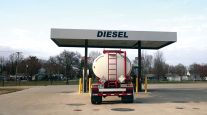Diesel Declines 3.7¢ to $2.833
This story appears in the Feb. 1 print edition of Transport Topics.
The U.S. retail diesel average price fell 3.7 cents a gallon to $2.833 last week, the largest one-week decline since July, the Department of Energy reported.
It was the second straight drop for commercial trucking’s main fuel, which now has dipped 4.6 cents during the span, after rising 15.3 cents over the three previous weeks.
The average price of gasoline fell 3.4 cents to $2.705 a gallon, which also was the steepest drop since July, DOE said after its Jan. 25 survey of fueling stations. Gasoline has fallen 4.6 cents over the past two weeks.
In spite of the declines, diesel remains 25% higher than it was a year ago — $2.268 a gallon — while gasoline was 47% higher than the corresponding week in 2009, when the national average stood at $1.838.
With the exception of the January run-up that pushed diesel close to $2.90 a gallon, diesel has hovered between $2.70 and $2.80 since October. One analyst said he expects the fuel to remain in that range.
“It’s quite a flat-table surface,” said Roger McKnight, senior petroleum analyst for En-Pro International. “I can see diesel hanging in there for quite a while.”
Explaining the declines, McKnight said that as the winter storms throughout much of the United States during December gave way to more moderate temperatures, heating oil demand tapered off, providing some relief for on-road diesel prices.
In addition, a glut of diesel imports from Europe has bolstered U.S. stockpiles, which should keep prices stable, McKnight added.
“Imports from Europe are kind of saving the day,” McKnight said.
U.S. stockpiles of ultra-low-sulfur diesel were at 100 million barrels as of Jan. 22, up from about 98 million barrels in the prior week, and up 84.8 million barrels a year earlier, according to the most recent DOE data.
Two carriers said that they are relying on fuel conservation efforts to guard margins in a cutthroat rate environment.
“We’re doing OK on fuel,” said Jeff Foster, CEO of Jeff Foster Trucking, Superior, Wis. “Our big issue right now is the economy and the poor rates.”
To protect profit margins, Foster said his company has started paying drivers bonuses for keeping their idling time down. The company bought auxiliary power units “about four years ago” to make idle reduction policies easier on drivers.
Foster said the APUs, driver training and lower truck speeds have boosted his company’s fleetwide fuel economy average to about 6.5 mpg from about 5.5 mpg. The carrier consumes about 300,000 gallons of diesel a month.
Doug Surrett, president of Purdy Brothers Trucking Co. in Knoxville, Tenn., said fuel was still “an ugly issue.”
Purdy Brothers, a refrigerated and flatbed carrier, runs 300 tractors, primarily east of the Mississippi River.
The company put incentives for conservative driving in place in late 2008 and has kept the initiative at the forefront of its driver training program.
By discouraging lead-footed driving and excessive idling, “we’re able to reduce our overall expenditure to the tune of 2% to 3%,” Surrett said. “The driver who can go from a stop to a start without spilling a cup of coffee that’s sitting on his dash is making his engine work a lot less.”
Purdy Brothers burns between 45,000 and 60,000 gallons of diesel a week, Surrett estimated, with about half of that being purchased at retail pumps.
Meanwhile, trucking companies that reported quarterly earnings last week made notably fewer mentions of fuel prices than in the last two years, when record prices and more volatility brought the issue to the forefront.
For example, truckload carriers Knight Transportation and Werner Enterprises and refrigerated carrier Marten Transport all reported a year-over-year decrease in fuel expenses in the quarter ended Dec. 31.
Knight said it spent about $39 million on fuel in the fourth quarter, about $2 million less than a year ago. At Werner, quarterly fuel expenses fell to about $73 million from about $85 million. In the same period, Marten spent $27 million on fuel, $5 million less than in 2008.
Also last week, the price of crude oil futures hovered around $75 a barrel — much higher than the average price of $43 a barrel in the last week of January 2009, but down modestly from the $80-a-barrel range where oil had been for most of last month, Bloomberg News reported.




